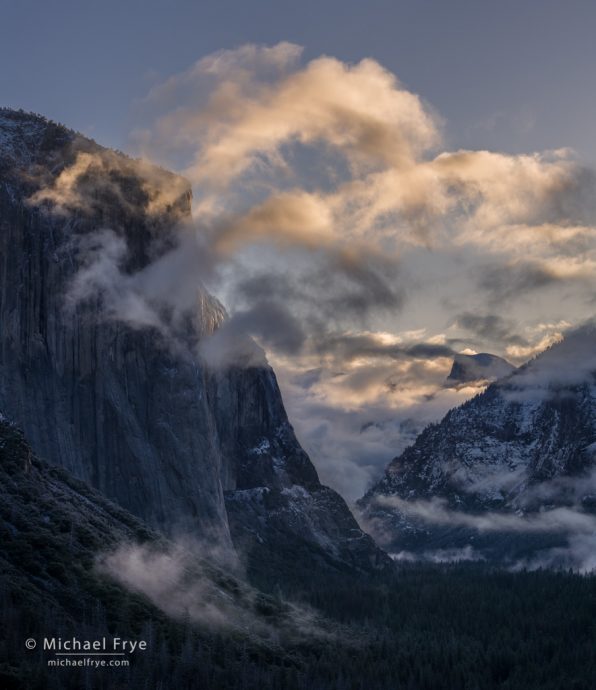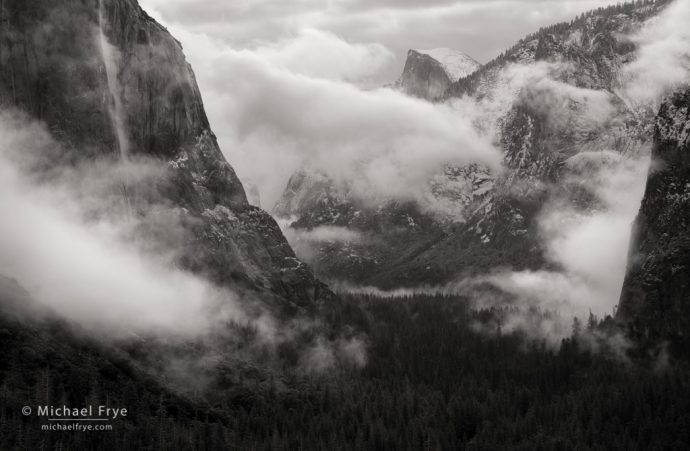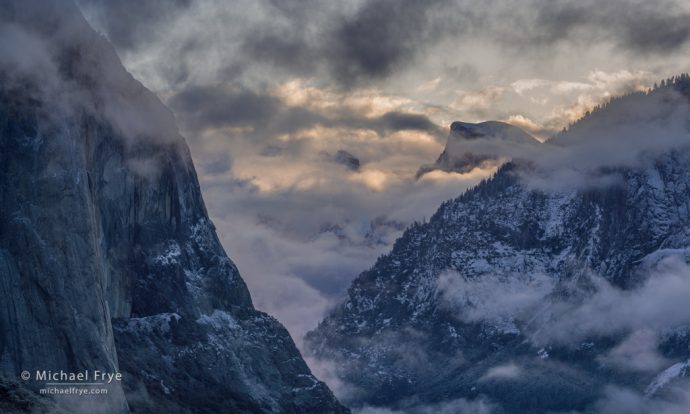We’ve had a series of storms recently. The last of these arrived Saturday and continued into the night. It wasn’t much of a storm; Yosemite Valley received only about three-tenths of an inch of water. But it was cold enough to leave a dusting of snow on the valley floor.
It looked like the storm would clear during the night, so I left for the valley around 11:00 p.m. Saturday, arriving just after midnight. But clouds and snow showers kept lingering so I ended up dozing in my car. I woke up around 5:30 a.m. and saw a few stars for the first time. At least the clearing seemed well-timed for sunrise.
I started at Tunnel View, joining about 20 other photographers. There was plenty of mist down low, but also a bank of higher clouds to the east. I knew that bank would block the early light and delay the sunrise, and once the sun climbed over that bank and above Cathedral Rocks it would be right in our faces. So I wasn’t actually very optimistic about the conditions. But the mist was interesting, and I could see some possibilities for black-and-white photos, so I decided to stay for awhile and see what happened.
The standard composition from Tunnel View is a horizontal image with a normal lens (around 40mm to 50mm with a full-frame sensor), putting El Capitan on the left side of the frame, with Bridalveil Fall and Cathedral Rocks on the right. (The first photo from my last post is a good example of this.)
This composition has become standard because it often works. But it’s not the only choice, or necessarily the best choice for a given moment. I’ve used every focal length from 16mm to 300mm from Tunnel View, in both vertical and horizontal orientation, depending on the light and weather at the time.
From our vantage point at Tunnel View, that early-morning cloud bank yesterday extended up above Half Dome, but didn’t reach the top of El Capitan or Cathedral Rocks. And above that cloud bank there was only bright, clear sky, much brighter than the mountains and mist. Including that bright sky in any composition would be problematic, because it would draw the viewer’s eye away from more interesting stuff below. So I had to leave out the top of El Cap and Cathedral Rocks, using my 70-200mm lens to concentrate on tighter views of the lower rock formations. Here the focal length was 110mm:
Around 7:30, about half an hour after sunrise, sunlight started to hit some of the clouds and mist around Half Dome. Unfortunately, Half Dome was mostly hidden, but soon more of it emerged, so I made another tight, telephoto composition (150mm):
And soon thereafter some of the mist started to lift, filling the formerly blank sky with some beautiful, curving shapes. I quickly zoomed out to 70mm, flipped the camera to a vertical orientation, and made the photograph at the top of this post. Then I put on my 50mm lens and made a horizontal image, but the tighter vertical worked better, because it filled the frame with only the parts of the scene with the most interesting light and clouds.
The clouds and mist kept shifting, and other interesting scenes presented themselves – all seeming to demand tight, telephoto compositions. The sun eventually crested Cathedral Rocks, shining right into our faces, and the mist started to dissipate. Time to move on. But it turned out to be a beautiful morning at Tunnel View, much better than I initially expected. You never know.
And throughout it all I kept adapting my compositions to the light, trying to find the framing that highlighted the most interesting part of the scene at that particular moment. The “standard” composition never seemed to quite work that morning, but fortunately there were many other possibilities.
— Michael Frye
Related Posts: Subject, Meet Light; Courting Luck, Part 2: Adapting Your Composition to the Conditions;
Michael Frye is a professional photographer specializing in landscapes and nature. He is the author or principal photographer of The Photographer’s Guide to Yosemite, Yosemite Meditations, Yosemite Meditations for Women, Yosemite Meditations for Adventurers, and Digital Landscape Photography: In the Footsteps of Ansel Adams and the Great Masters. He has also written three eBooks: Light & Land: Landscapes in the Digital Darkroom, Exposure for Outdoor Photography, and Landscapes in Lightroom: The Essential Step-by-Step Guide. Michael has written numerous magazine articles on the art and technique of photography, and his images have been published in over thirty countries around the world. Michael has lived either in or near Yosemite National Park since 1983, currently residing just outside the park in Mariposa, California.












Hi Michael, I was there Yesterday morning at tunnel view, but I was at a higher elevation. If I knew you were there, I could have said hi to you. I saw Franka Gabler, too.The vista from tunnel view was amazing, and I took some photos and I have some keepers I think. I stayed all day until sunset, and we had some good light at the end of the day illuminating catedral rock I think is the name of the granite formation just across from El Capitan. I saw your exhibit at the Ansel Adams Gallery, and you have beautiful pieces of art decorating the gallery’s walls indeed. Congratulations for your exhibition Michael. I ordered one of your prints because they did not have it available at the gallery. In a few days I will have your piece of art hanging on my house’s walls for inspiration. Thank you and see you soon. mARTin
I’m sorry I missed you there Martin. I saw Franka and Dave Hoffman too, so I’m puzzled by your statement that you were at a higher elevation. Were you back behind Tunnel View somewhere? In any case, I’m glad you got to photograph the clearing storm yesterday morning, as it sure was nice. And thanks for the kind words about the exhibit – and for purchasing a print!
Indeed I was behind you guys on the little trail just above the tunnel. The brush is quite big now, so some of it is shown in my photographs. I did not get a good spot by tunnel view so I wanted to try a different perspective. I saw Dave, too, he was to my right. What a cold morning that was! I love photographing clearing storms just like you do, for they offer a great deal of opportunities. I purchased your print, Horse Tail at sunset. The big and beautiful size print you have on display at the gallery looks fantastic! Great job Michael! I love the fact that 101/150 prints have been sold.
Thanks for the clarification Martin. And thanks for purchasing a print! Glad you like that image.
More photographers should read your article… It’s surprising how many do not see the possibilities with a telephoto lens and landscapes. Incredible work Michael!
Thanks Nelson. Yeah, it’s a mystery why so many photographers landscape photographs can only be made with wide-angle lenses. Ansel Adams certainly never thought that way. Even David Muench, who practically invented the super wide-angle, near-far look, made many of this best images with telephoto lenses.
These Images Are So Fantastic Michael
Thank you John!
As always, not only gorgeous, but inspiring! What I’ve come to really enjoy are the insights you share in each post, too; I own your indispensable Yosemite photography guide book as well as a video or two, but your blog posts are almost like having you right there to explain and brain-pick . . .
So, my question this time is neither technical nor aesthetic: you mentioned dozing in your car from about midnight to near-dawn. Where in/near the park can one legally/safely do that? Your results are clearly worth whatever regulations may have been breeched!
Ron
Thanks very much Ron! You’re not supposed to spend the night in your vehicle in the park except in a designated campground. Dozing for a couple of hours is a gray area.
Hi Michael…unrelated question, but I was wondering if you had seen any good poppy blooms going over 140 into Yosemite? I kind of tend to doubt it, given the weather and the fact that Daffodil Hill didn’t even open this year.
I look forward to any info you can share, and as always, I really enjoy looking at your photos…
Cliff Butler
I haven’t been to the Merced River Canyon in weeks, so I don’t have anything to report. I heard there were some nice poppies about two weeks ago.
You excellently use the telephoto lens to shoot the landscape. This is a very good skill. Thank you for the article.
Thanks Marat. For some reason people often equate landscape photography with wide-angle lenses. That’s a new idea, actually. Ansel Adams, Eliot Porter, Edward Weston, Philip Hyde, and all the landscape masters from the last century used telephoto lenses all the time. Even David Muench, who really popularized the super-wide-angle, near-far look in landscape photography, frequently used telephoto lenses for his compositions. The best lens for landscape photography is the lens that works for the situation at hand.